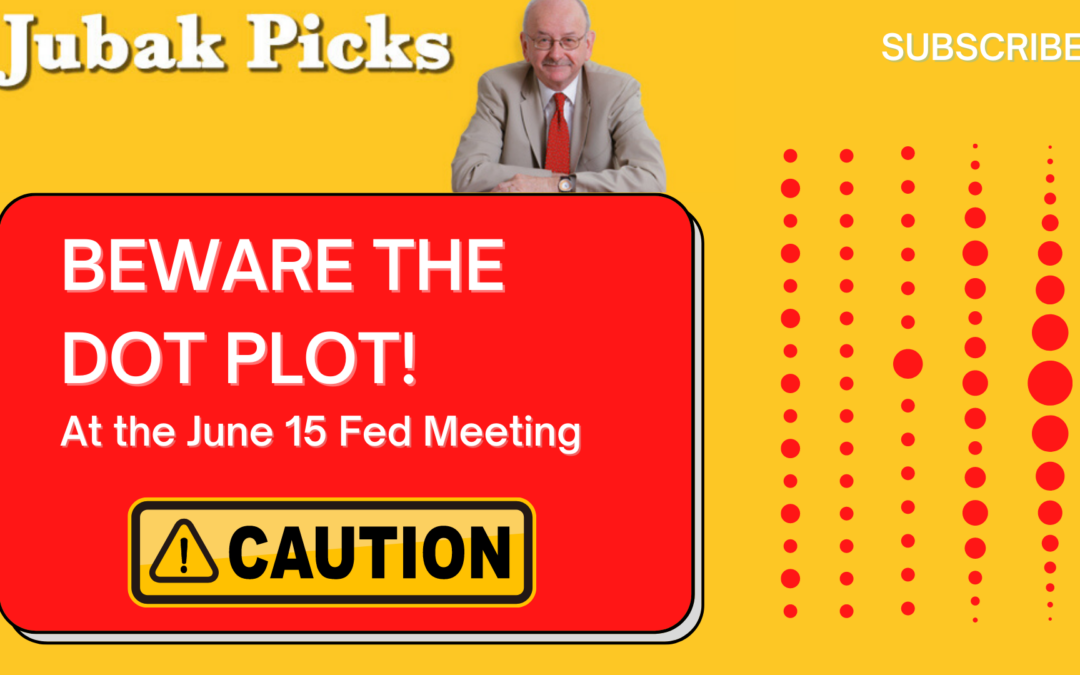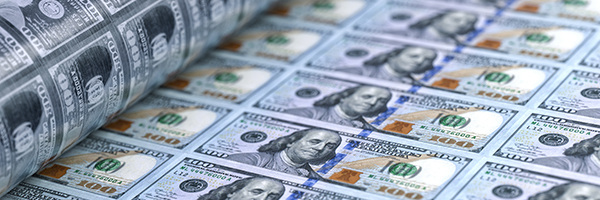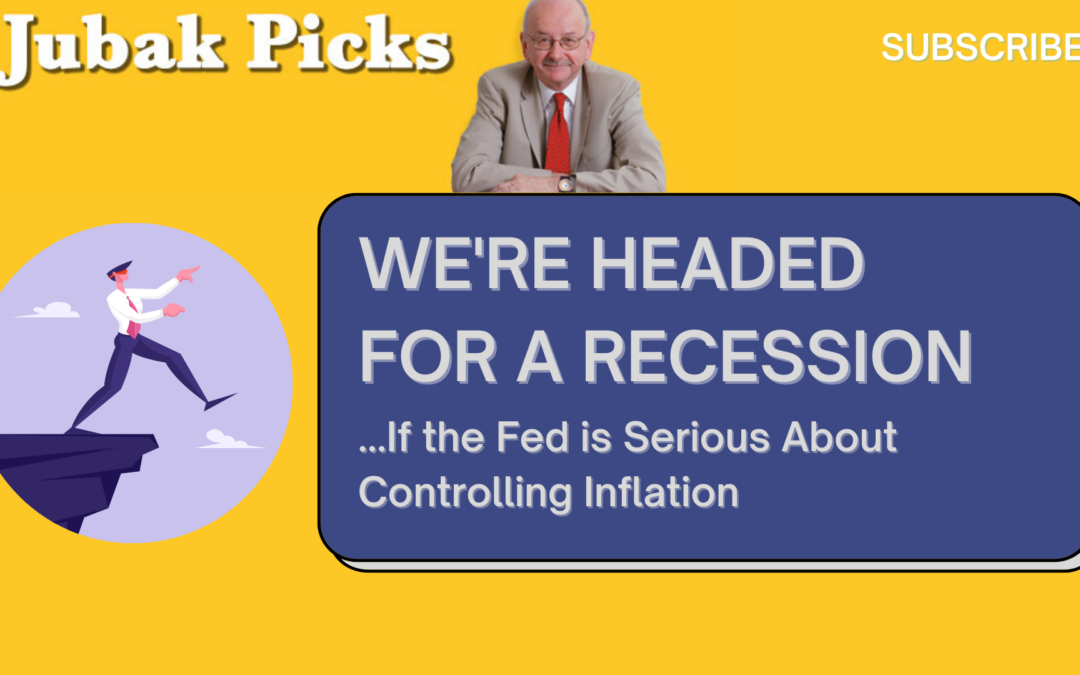
June 2, 2022 | Daily JAM, Morning Briefing |
The U.S. economy added 390,000 jobs in May, the Labor Department reported this morning. Economists had expected the economy to add 318.000 jobs for the month. In April the economy added a revised 436,000 jobs. The unemployment rate stayed steady at 3.6%. Economists had expected a drop to 3.5%.

June 2, 2022 | Daily JAM, Short Term, You Might Have Missed |
My one-hundredth-and-thirty-ninth YouTube video “Beware the Dot Plot” went up today. The next Fed meeting is June 15, and I think there isn’t much to worry about in terms of a coming rate increase (we know it will be 50 basis points, which the market has priced in). What you do need to look out for, however, is the Dot Plot. This communicates Fed members’ expectations for growth and inflation in the coming years, and if they foresee stickier inflation AND slower economic growth, the market won’t be happy.

June 2, 2022 | Daily JAM, Morning Briefing |
Another Federal Reserve official talked the interest rate increase talk today. Federal Reserve Vice Chair Lael Brainard told CNBC that expectations for half-percentage-point increases in interest rates this month and next were reasonable, and saw no case for pausing the central bank’s tightening campaign afterward. “From where I sit today, market pricing for 50 basis points, potentially in June and July, from the data we have in hand today, seems like a reasonable path.”

May 31, 2022 | Daily JAM, Videos |
My one-hundredth-and-thirty-eighth YouTube video “Housing market cools” went up today. We’re seeing some of the first effects of the Fed’s increase in interest rates in the cooling of the housing market. In Austin, for example, the percentage of active listings with price cuts has increased, and we have seen the lowest number of new purchases since the start of the pandemic. Since many American families have a large portion (or all) of their wealth stored in their home, housing prices have a big effect on consumer spending. We might expect to see that slow consumer spending, which would help to control inflation.

May 30, 2022 | Daily JAM, Morning Briefing |
Federal Reserve Governor Christopher Waller said today, May 30, that he wants to keep raising interest rates in half-percentage point steps until inflation is easing back toward the central bank’s goal of 2%. “I support tightening policy by another 50 basis points for several meetings,” he said. “In particular, I am not taking 50 basis-point hikes off the table until I see inflation coming down closer to our 2% target.” Waller is the first Fed official to speak on interest rate policy after last week’s rally and ahead of the quiet period that begins Saturday and runs through the Fed meeting on June 15. On Sunday I posted that the tenor of Fed comments this week would go a long way to demonstrating whether the Powell Put–the Fed’s de facto policy of propping up stocks on a decline–was still in effect or if it had been replaced by a policy of subtly encouraging orderly (of course) market retreats as an aid to fighting inflation.

May 29, 2022 | Daily JAM |
Almost everyone believes that the Federal Reserve will raise its benchmark short term interest rate by 50 basis points at its June 15 meeting. The CME FedWatch Tool put the odds of a 50 basis point increase at 93.3% on Friday. But last week saw a small, but I think significant, shift in thinking about the July 29 meeting. And I think that shift was one of the reasons for last week’s rally. So it is of some interest to traders and investors whether this shift continues into this coming week.

May 29, 2022 | Daily JAM, Weekend JAM |
I’m looking for a test of the new “Fed Call” theory.
A few weeks ago, before last week’s rally anyway, the theory starting going around that the “Fed Put” (sometimes called the “Powell Put”) was dead. The Fed Put (in place since the days when it was called the “Greenspan Put”) held that investors and traders didn’t have to worry about the dangers of a big downside move in the stock market because the Federal Reserve would ride to the rescue, flooding the financial markets with cheap money, and rescuing stocks. The new thinking, however, was that with the Fed looking to contain potentially run-away inflation, the Fed would be happy to see stocks take a substantial but not dangerous tumble because that would act to damp sentiment and restrain spending. A decline in stock prices was, for this point of view, an ally of the Fed’s policy of increasing interest rates. The question is, of course, how active the Fed would be in “encouraging” a decline in stock prices

May 27, 2022 | Daily JAM, Videos |
My one-hundredth-and-thirty-seventh YouTube video “We’re headed to a recession…if the Fed is serious about fighting inflation” went up today.

May 27, 2022 | Daily JAM |
In today’s YouTube video I argue that the Federal Reserve will have engineer a recession if it is serious about bringing inflation under control. This post gets more into the specific details of why I think that’s true than the video does. (I suggest reading this and watching the video “We’re headed to a recession.”)
The Federal Reserve isn’t staffed by mean old orcs (as far as I know) determined to bring on a recession because they think it’s fun to inflict economic pain on 350 million people. No, a recession is coming because 1) the Fed has only very limited, very blunt tools for fighting inflation, and 2) those tools aren’t very effective against the kind of inflation that is on the prowl in the current economy.

May 25, 2022 | Daily JAM, Morning Briefing |
Minutes from the Federal Reserve’s May 4 meeting shows central bank officials in agreement on the ned for 50-basis-point interest rate increases at the June and July meetings. And then, the minutes say, the Fed would respond to developments in the economy either with more interest rate increases or a pause to let the economy recover. That’s essentially in line with market sentiment–although Wall Street may be more convinced of the need for a September interest rate increase. That agreement was reassuring to the stock market today.

May 19, 2022 | Daily JAM, Jubak Picks, USB |
Back on April 11 when I sold Wells Fargo (WFC) and the Invesco KBW Bank ETF (KBWB) out of portfolios to reduce my exposure to a slowing economy caused by the Federal Reserve interest rate increases, I kept my position in U.S. Bancorp (USB) because I wanted to collect the dividend due to be paid out on April 15 (and because I thought super-regional U.S. Bancorp, as one of the best managed banks in the country, was less exposed to the downward trend in the sector.) Well, as of May 19, I’ve certainly collected my quarterly dividend (the stock current yields 3.75%) and the downward trend in financial stocks has picked up speed with the Fed announcing (well, as close to “announcing” as the Fed ever does) interest rate increases for the June, July and September meetings of the central bank, so I’ll be selling U.S. Bancorp out of my Jubak Picks Portfolio tomorrow May 20.

May 12, 2022 | Daily JAM |
But did he have to say it? The financial market would prefer not to think about inflation all the time. The markets are indeed pretty good at ignoring the inconvenient. But this morning Federal Reserve Bank of St. Louis President James Bullard said out loud what Wall Street knows in its heart but doesn’t want to think about. “Inflation is broader and more persistent than many have thought and the Fed will have to act in order to keep inflation under control and we’ve got a plan in place,” Bullard told Yahoo Finance Wednesday.












